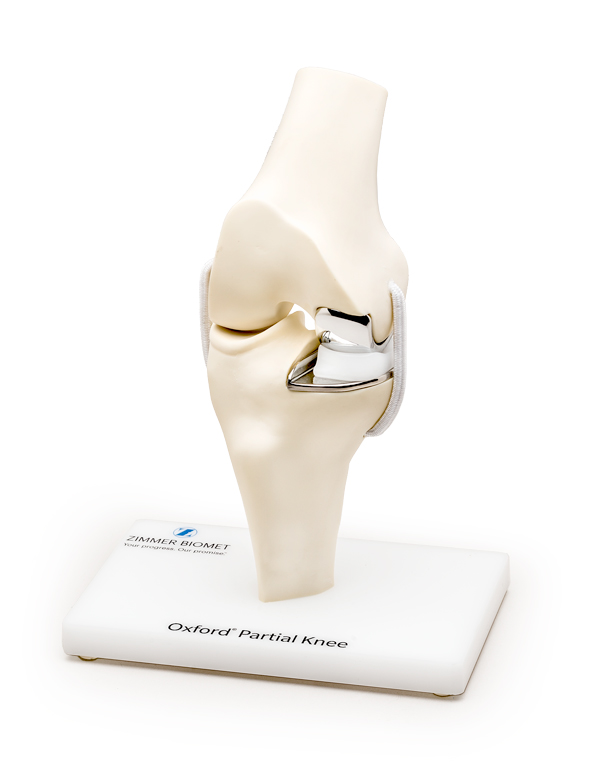
Chronic, severe knee pain greatly affects your everyday life. Walking can hurt so much that you may avoid exercise and recreational activities. The pain may even keep you up at night. Your doctor may have referred your to a knee replacement specialist to talk about getting knee replacement surgery with you, or you may be avoiding going to the doctor for your knee pain because you fear surgery. The good news is you have options. Knee surgery technology has improved by leaps and bounds. There is an alternative to total knee replacement – a partial knee replacement.
Because not all surgeons offer partial knee replacement, it’s important for patients to be educated about their options. Partial knee replacement has many benefits, including shorter recovery time and a more natural feeling knee. However, a partial knee replacement isn’t always a feasible option if the knee is seriously damaged. Although it takes longer to recover from a total knee replacement, sometimes it’s better to have the knee totally replaced to avoid further surgery in the future. This site talks specifically about Physical Therapy After a Total Knee Replacement because the recovery time is far greater and will require more therapy afterward but if a doctor is happy that your knee only requires a partial replacement, then you can take advantage of the new technology.
In the past, even if you only had damage in one part of your knee, total knee replacement was your only option. Technological advances such as 3-D magnetic resonance imaging, robotic assistance and computer navigation have changed that – making partial knee replacement surgery the best choice for many patients.
I use the Oxford® Partial Knee, a widely used and clinically proven prosthesis, because the moveable plastic bearings have demonstrated low wear rates. This partial knee can last up to 30 years, providing many patients a good long-term solution.
Image provided by Zimmer Biomet.
The difference between full and partial knee replacement
The knee is made up of bones, cartilage, ligaments and tendons. It has three compartments: one inside the joint, one on the outside and one behind the kneecap. In full knee replacement surgery, the entire knee joint is removed and replaced with a prosthesis.
If your knee pain is being caused by damage in only one compartment, you could be a candidate for partial knee replacement surgery. In a partial knee replacement, only the damaged part of the knee is replaced with plastic and metal components. The ligament connecting the thigh and femur bones is left intact, and more nerve pathways are left undamaged.
The benefits of partial knee replacement
Benefits of partial knee replacement surgery include:
- Feels more like a natural knee.
- Less pain and blood loss.
- Smaller scar.
- Quicker recovery time: patients who undergo partial knee replacement recover in half the time as those who have full knee replacements.
- More likely to be performed as an outpatient or “same day” procedure. This means the patient returns home after the surgery rather than staying overnight at the hospital. An outpatient surgery usually costs less and it reduces the risk of hospital-acquired infections.
- Less likely to have residual symptoms. Up to one third of patients who have full knee replacements continue to experience some symptoms like pain and stiffness. That rate is much lower for people who have partial knee replacement. Less than ten percent have residual symptoms.
Although there are benefits to partial knee replacement surgery, don’t despair if you are not a candidate. Studies have shown that both partial and full knee replacement surgeries have excellent short-term and long-term results.
Who is a candidate for partial knee surgery?
Patients with arthritis or osteoarthritis are great candidates for a partial knee replacement surgery. Technological advances mean partial knee surgery can be performed on both older patients and young, active patients.
There are some factors that influence whether or not you are a candidate for partial knee replacement. To be a candidate you must have:
- Damage to only one compartment of the knee
- Key ligaments are intact
- Sufficient range of motion
- Overall knee stability
Additionally, joint deformities caused by arthritis can affect whether or not a patient is a candidate for partial knee replacement surgery.
It’s important to remember that not all knee pain leads to surgery. There are other options to treat your knee pain before surgery, including medication, physical therapy, a knee brace and strength training. Changes to your diet and exercise can also reduce knee pain. Most of the time the problem, if there is one, won’t be as severe as you first thought. In some cases, all it may take is an effective form of pain relief, similar to the products that can be found at places like Every Day Optimal CBD, and some much-needed relaxation to help reduce your knee pain. As well as that, losing weight takes the pressure off your knees. Replacing high-impact sports like running or basketball with low-impact activities like walking and swimming can greatly reduce knee pain.
As a patient it’s wise to be educated about your options. If you are considering knee surgery, ask your doctor whether or not he or she performs partial knee replacements. You may want to seek a second opinion from a surgeon who performs both procedures to establish if you are a candidate for partial knee replacement surgery.



Thanks for explaining the differences between partial and full knee surgery as well as for explaining how patients who have arthritis or osteoarthritis can consider these options no matter their age. It’s also great that you recommend talking to your primary doctor about whether they perform these replacements as well as to a specialist. When choosing a specialist, it would probably help to get recommendations from your doctor as well as research online to find an expert that can teach you more about knee surgery and help you determine if this option is a good idea for your situation.